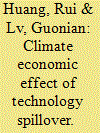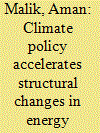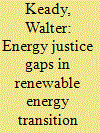|
|
|
Sort Order |
|
|
|
Items / Page
|
|
|
|
|
|
|
| Srl | Item |
| 1 |
ID:
181801


|
|
|
|
|
| Summary/Abstract |
Sustainable bioenergy production is required to meet the growing demand and environmental concerns. This study addresses current and advanced options for biomass-based electricity generation integrated to a sugarcane ethanol distillery in Brazil and polices that would foster its deployment. The typical combustion and steam cycle system and the integrated gasification combined cycle are the options considered for lignocellulosic biomass conversion into heat and power, associated with carbon capture and storage technologies. Besides conventional sugarcane, eucalyptus and energy-cane are also examined as promising feedstocks to extend operational days and/or increase biomass yields. The considered biomass-based electricity options are able to mitigate climate change impacts and depletion fossil resources. However, decreasing costs is a challenge to overcome for its broader implementation. The assessed strategies may help to guide policymakers on how to feasibly deploy advanced technologies for electricity production from biomass, meeting the future demands for sustainable electricity. The choice of larger processing scales shows an important effect on reducing costs, as well as choosing energy-cane as feedstock, which is also favorable for reducing climate change and land use impacts. Likewise, government policies that reward climate mitigation, as RenovaBio in Brazil, have a prominent role to foster advanced biomass-based electricity production technologies.
|
|
|
|
|
|
|
|
|
|
|
|
|
|
|
|
| 2 |
ID:
181772


|
|
|
|
|
| Summary/Abstract |
In the context of the practice of high-quality social development gradually deepening, the optimization of energy structure is an important link to promote high-quality economic development. We used China's historical data from 1980 to 2019, and identified 17 influencing factors of its energy consumption structure. From four dimensions (economy, structure, technology, population and policy), Copula function was employed to establish a multi-factor dynamic support vector machine model to predict the advanced index of energy consumption structure in 2020–2030. The results show that (a) China's energy consumption structure is being optimized. An up-trend is found in the advanced index of China's energy consumption structure, and the proportion of its coal consumption shows a downward trend, but the decline is gradually decreasing. (b) Energy price adjustment, increased rural income, industry structure improvement, higher R&D expenses contribute to energy consumption structure optimization in China. (c) China is able to meet the carbon emission target set for 2030 on schedule. China is expected to reach carbon emission peak in 2030, and non-fossil energy will account for about 21% in 2026. The carbon emission target per unit of GDP is expected to be completed ahead of schedule.
|
|
|
|
|
|
|
|
|
|
|
|
|
|
|
|
| 3 |
ID:
181806


|
|
|
|
|
| Summary/Abstract |
Two financial incentives that have spurred the growth of renewable energy including wind farms are Production Tax Credits (PTC) and Property Tax Abatement (PTA). PTC provides a tax credit of 1¢–2¢ per kilowatt-hour for the first 10 years of electricity generation for utility-scale wind, and PTA is a rebate provided by the local governments to wind farms in the U.S. Midwestern states. Past researches suggest that the breaking-even of renewable energy projects can partly be attributed to PTC. However, in cognizance of the irregular availability of such incentives, there seems to exist a need for financial feasibility analysis of the wind farms. The study uses a stochastic method and a scenario approach to address this research question. The analysis considers the capital and operating costs, interest payments, local and federal taxes, and production of wind energy and sales revenues, and inherent uncertainties in key parameters. The results shed some light on the impacts of PTC and PTA on the financial feasibility of wind farms in the U.S. Midwestern states. It is observed that PTC is a more effective instrument compared to PTA. The paper concludes by discussing policy implications of local government rebates and federal incentives.
|
|
|
|
|
|
|
|
|
|
|
|
|
|
|
|
| 4 |
ID:
181762


|
|
|
|
|
| Summary/Abstract |
Energy Performance Certificates (EPCs) and EPC digital registers are key tools to evaluate different aspects of the building stock and its energy consumption. This paper presents several detailed energy performance evaluations on the Italian buildings based on a sample of over 2,000,000 EPCs extracted from the national EPC register (SIAPE), contributing to the definition of an updated energy performance baseline of the Italian building stock. This is the first work using the Italian EPC register to define such a baseline to the extent of the authors’ knowledge. Furthermore, combined analyses of EPC data were carried out to obtain information on the influence of the Italian energy regulations on building characteristics and on the effectiveness of energy strategy application for building renovation.
|
|
|
|
|
|
|
|
|
|
|
|
|
|
|
|
| 5 |
ID:
181768


|
|
|
|
|
| Summary/Abstract |
Energy security and environmental concerns are critical issues for North America. The development of the bio-fuel industry has given grain farmers another crop option. Trends towards renewable fuels could also put fuel production at odds with traditional food agriculture, a situation referred to as the “food vs. fuel” debate. This research models profit maximizing farm crop choices as energy crops become a crop option. We develop a simulation to estimate the oil price level where farmers would switch from the production of grain for food over to bio-energy crops. We also investigate consequences associated with this process on the elevator industry.
|
|
|
|
|
|
|
|
|
|
|
|
|
|
|
|
| 6 |
ID:
181761


|
|
|
|
|
| Summary/Abstract |
Internal Carbon Pricing (ICP) is a tool for companies to internalize negative external effects caused by their carbon emissions and to prepare themselves for a low-carbon economy. Globally, an increasing number of companies adopts ICP. Yet, many German firms do not use it yet. This paper explores why German companies do not adopt ICP and which barriers hinder the proper implementation of the instrument drawing on the concept of eco-innovation. Eighteen semi-structured interviews were conducted and analyzed using a structuring qualitative content analysis. The findings show that small companies face particularly strong challenges to mobilize the financial, technical, and informational resources necessary for the implementation of ICP. Internal carbon price levels similar to existing external carbon pricing schemes fail to unfold a steering function, because these prices are currently too low. Further difficulties arise due to the complexity of correctly accounting for GHG emissions and setting the right carbon price. The paper highlights the need for stringent external carbon policies on a national and European level, for more external information on ICP, and for the facilitation of cooperation between companies in order to increase the adoption rate and the efficacy of ICP in Germany.
|
|
|
|
|
|
|
|
|
|
|
|
|
|
|
|
| 7 |
ID:
181764


|
|
|
|
|
| Summary/Abstract |
Globally, 2.6 billion people still cook with biomass, resulting in interlinked health, environmental and drudgery challenges. The uptake of improved biomass cookstoves has barely kept up with population growth, yet SDG7 hopes for universal access to modern energy by 2030. This paper explores a potentially transformative new approach to facilitate access to affordable, reliable, sustainable and modern energy for cooking by leveraging rapid progress in electrification and falling prices of solar PV and lithium-ion batteries: battery-supported electric cooking. This paper presents empirical evidence on energy use, menu choices and cooking preferences from 83 households in 4 countries who transitioned from other fuels to electric cooking. A techno-economic model demonstrates that battery-supported electric cooking can be cost competitive with current expenditures on cooking fuels. No significant change in household menus occurred and the energy-efficient devices enabled 100% of everyday cooking with just 0.87–2.06 kWh/household/day. Our initial findings have already directly influenced the development of a 5-year UKAid-funded programme in collaboration with the World Bank, ‘Modern Energy Cooking Services’, and the new draft energy policy in Uganda. The paper concludes with two key policy recommendations: design lifeline tariffs inclusive of cooking and develop local markets for culturally-appropriate, quality-assured, energy-efficient cooking appliances.
|
|
|
|
|
|
|
|
|
|
|
|
|
|
|
|
| 8 |
ID:
181793


|
|
|
|
|
| Summary/Abstract |
There is increasing interest in the global CO2 emissions transfer caused by international trade. However, the reduction potential of technology spillover is rarely considered. More importantly, the effect of technology spillover on climate change and the social cost of carbon (SCC) should be further investigated to inform climate policy-makers. In this study, we investigate the climate economic impact of technology spillover through unidirectional coupling of the emissions embodied in bilateral trade (EEBT) method and the dynamic integrated model of climate and economy (DICE). The results indicate that technological progress in the electricity sector could contribute to climate change mitigation and SCC lowering. The trade-related CO2 emissions of key CO2 exporters could be substantially reduced, such as China, India, Russia, and resource- and labor-intensive countries. High-tech countries outsourced large amounts of CO2 emissions to labor- and resource-intensive countries. However, a large income gap remains between high-tech and labor/resource-intensive countries. These results indicate the great importance of technological progress and sustainable management throughout the global supply chain.
|
|
|
|
|
|
|
|
|
|
|
|
|
|
|
|
| 9 |
ID:
181787


|
|
|
|
|
| Summary/Abstract |
The employment implications of decarbonizing the energy sector have received far less attention than the technology dimension of the transition, although being of critical importance to policymakers. In this work, we adapt a methodology based on employment factors to project future changes in quantity and composition of direct energy supply jobs for two scenarios - (1) relatively weak emissions reductions as pledged in the nationally determined contributions (NDC) and (2) stringent reductions compatible with the 1.5 °C target. We find that in the near-term the 1.5°C-compatible scenario results in a net increase in jobs through gains in solar and wind jobs in construction, installation, and manufacturing, despite significant losses in coal fuel supply; eventually leading to a peak in total direct energy jobs in 2025. In the long run, improvements in labour productivity lead to a decrease of total direct energy employment compared to today, however, total jobs are still higher in a 1.5 °C than in an NDC scenario. Operation and maintenance jobs dominate future jobs, replacing fuel supply jobs. The results point to the need for active policies aimed at retraining, both inside and outside the renewable energy sector, to complement climate policies within the concept of a “just transition”.
|
|
|
|
|
|
|
|
|
|
|
|
|
|
|
|
| 10 |
ID:
181808


|
|
|
|
|
| Summary/Abstract |
Fuel economy regulation is a powerful instrument to reduce CO2 emissions of vehicles and has recently been extended to heavy-duty vehicles. In Europe, truck manufacturers are required to reduce the CO2 emissions of newly sold vehicles by 30% until 2030 compared to 2019/2020. Accordingly, several manufacturers have announced the introduction of zero emission vehicles (ZEVs) such as battery electric or fuel cell trucks. However, the sales shares of zero emission trucks to meet the targets have not been analyzed in the literature yet. Here, we derive sales share scenarios for zero emission trucks in Europe based on emissions reduction options and their associated costs. We find that manufacturers will require at least 4–22% of their newly sold heavy-duty vehicles to be zero emission in 2030, depending on their strategy to improve their diesel trucks. This implies a stock share of 2–11% for ZEV trucks in Europe in 2030. Yet, high sales shares for ZEVs and the super credits granted by the regulation allow manufacturers to meet their target with little CO2 reduction in the conventional fleet leading to low actual emission reduction.
|
|
|
|
|
|
|
|
|
|
|
|
|
|
|
|
| 11 |
ID:
181796


|
|
|
|
|
| Summary/Abstract |
By 2030, Austria aims to meet 100% of its electricity demand from domestic renewable sources, such as wind energy. Apart from the benefit of reducing CO2 emissions and, potentially, system cost, wind power is also associated with negative impacts at the local level, particularly its interference with landscape aesthetics. Some of these negative impacts might be avoided by using alternative renewable energy technologies. To better understand the trade-offs involved, we quantify the opportunity cost of wind power versus its best feasible alternative, which is solar photovoltaics in Austria. Methodologically, our analysis relies on the power system model medea, a technology-rich, partial-equilibrium model of the Austro-German electricity and district heating markets. Our findings suggest that the cost of undisturbed landscapes is considerable, even more so when solar PV is mainly realised on rooftops. Under a wide range of assumptions, the opportunity cost of wind power is high enough to allow for significant compensation of the ones affected by local, negative wind turbine externalities.
|
|
|
|
|
|
|
|
|
|
|
|
|
|
|
|
| 12 |
ID:
181802


|
|
|
|
|
| Summary/Abstract |
The UN Sustainable Development Goals (SDGs) and the Paris Agreement have ushered in a new era of policymaking to deliver on the formulated goals. Energy policies are key to ensuring universal access to affordable, reliable, sustainable, and modern energy (SDG7). Yet they can also have considerable impact on other goals. To successfully achieve multiple goals concurrently, policies need to balance different objectives and manage their interactions. Refining previously contemplated design principles, we identify three key principles - complementary, transparency and adaptability - as highly pertinent for multiple-objective energy policies based on a synthesis of seventeen coordinated policy case studies. First, policies should entail complementary measures and design provisions that specifically target non-energy objectives (complementarity). Second, policy impacts should be tracked comprehensively in both energy and non-energy domains to uncover diminishing returns and facilitate policy learning (transparency). Third, policies should be capable of adapting to changing objectives over time (adaptability). These principles are rarely considered in current policies, implying the need to mainstream them into the next generation of policymaking by pointing to best practices and new tools.
|
|
|
|
|
|
|
|
|
|
|
|
|
|
|
|
| 13 |
ID:
181790


|
|
|
|
|
| Summary/Abstract |
This study explores different energy consumption vectors during the first year of the COVID-19 pandemic in Portugal. Most of the workforce started working from home and resource consumption significantly shifted towards the domestic sector. The ensuing confinement protocols caused a shift in everyday life, which in turn significantly altered the energy supply and demand landscape. This event, although catastrophic in terms of loss of human life and economic development, can provide us with valuable data to study the potential of new strategies to achieve EU 2050 Energy goals. It was investigated whether the pandemic has opened a path and provided us with a partial answer to decarbonization in the form of home office practices as a possible energy efficiency measure. The present study shows that, in Portugal, there was a 15.7% reduction of primary energy consumption (accounting for electricity, natural gas and transport fuels) compared to 2019. The data suggest that actions targeting reduced mobility, such as home office practices and the decentralization of the workforce, could be a relevant energy efficiency measure.
|
|
|
|
|
|
|
|
|
|
|
|
|
|
|
|
| 14 |
ID:
181792


|
|
|
|
|
| Summary/Abstract |
Mega-events can improve pro-environment consciousness and decrease natural environmental pollution. However, they also increase infrastructure investment, consume more iron and steel, and cause pollution. Nanjing hosted the second Youth Olympic Games in 2014. Here, we investigated the impact of the Nanjing Youth Olympic Games (NYOG) on environmental efficiency (EE) of the host city. We used a quasi-natural experiment to assess the impact of the NYOG on EE in Jiangsu before, during, and after the phase of NYOG. We compare different policy shock effects of bidding for and hosting NYOG on EE. The empirical results confirm that hosting NYOG in 2014 improved EE in the host city, which has higher effect on the adjacent cities. EE after the phase of NYOG declined in the host city. Policy shock of bidding for NYOG in 2010 also enhanced EE in the host city. Moreover, environmental stringency had a positive effect on EE. These findings support the importance of promoting green Olympic Games via renewable energy use, green innovation, and materials recycling.
|
|
|
|
|
|
|
|
|
|
|
|
|
|
|
|
| 15 |
ID:
181794


|
|
|
|
|
| Summary/Abstract |
Understanding future trajectory of urban residential building carbon emissions (URBCE) is essential to seeking effective carbon-abatement pathways to combat climate change. However, future evolutionary trajectory, possible emission peaks and peaking times in this sector are still unclear. This study innovatively develops an integrated dynamic simulation model by embedding a bottom-up building end-use energy model into the system dynamics model. Based on this, scenario analysis approach is combined with Monte Carlo simulation method to explore the possible emission peaks and peaking times considering the uncertainties of impact factors. We apply the integrated SD-LEAP model to Chongqing, a typical city in China's hot-summer and cold-winter zone. Results show that URBCE will probably peak at 22.8 (±8.0) Mt CO2 in 2042 (±3.4)—well beyond China's 2030 target. Different building end-uses present substantial disparities. The contribution of combined heating and cooling to URBCE mitigation will be over 60% between business-as-usual and low-carbon scenarios. Dynamic sensitivity analysis reveals that per capita gross domestic product, carbon emission factor, and residential floor space per capita can boost emission peaks and peaking time. This study can not only boost the theory and model development for carbon emission prediction, but also assist governments to set effective carbon-reduction targets and policies.
|
|
|
|
|
|
|
|
|
|
|
|
|
|
|
|
| 16 |
ID:
181798


|
|
|
|
|
| Summary/Abstract |
How to achieve no poverty and reduce inequalities are among the core mission of the United Nations sustainable development goals. These goals also play an important role in China's poverty alleviation. In this paper, energy consumption is used as a proxy to measure living standards. Based on the data of 1010 Chinese households in 100 villages, energy consumption status and corresponding inequality at the village level were analyzed. The results showed that the per capita energy consumption of rural areas in China in 2018 was 862.94 kg coal equivalent, among which the main types were biomass and electricity. The regression analysis shows that the latitude and altitude, the distance to county center of the villages, average age, education level, and financial assets of the villagers are the main factors affecting the energy consumption of the villages. With the increase of per capita energy consumption, the Gini coefficient and Theil index both showed a downward trend, meaning energy poverty alleviation and inequality reduction are simultaneously achieved in rural development. The results of this study identify the key factors needed to increase energy consumption and energy efficiency at the village level and provide valuable reference for China's rural energy transformation.
|
|
|
|
|
|
|
|
|
|
|
|
|
|
|
|
| 17 |
ID:
181789


|
|
|
|
|
| Summary/Abstract |
Millions of Americans are unable to pay their energy bills and face the risk of being disconnected from their energy providers. This problem has grown significantly worse during the COVID-19 pandemic, with low-income households, households of color, and households with vulnerable populations particularly hard-hit by these conditions. In the early months of the pandemic, many states imposed temporary protections on utility disconnection but, as time has evolved, nearly all of these protections have lapsed. An increasing lack of protection has serious implications for vulnerable populations. Here, we present the extent of the energy insecurity problem in the United States, discuss the design and evolution of state disconnection protections, and offer policy recommendations for addressing this imminent challenge.
|
|
|
|
|
|
|
|
|
|
|
|
|
|
|
|
| 18 |
ID:
181783


|
|
|
|
|
| Summary/Abstract |
This study examines how renewable energy policies in Vermont address energy vulnerability and energy justice. Using an anti-resilience framework, and drawing on 569 surveys and 18 interviews statewide, our results demonstrate higher energy vulnerability—lack of access to sufficient and affordable energy—among respondents who are low-income, non-white, and renters. Low-income and renter respondents were over three times more likely, and non-white respondents were seven times more likely, to report going without heat. While Vermont is regarded as a renewable energy leader, its current policies do not equitably distribute household transition benefits (HTBs) to address vulnerability. Our results show that non-white respondents were seven times less likely than white respondents to report having solar panels and renters were three times less likely than homeowners to report having solar panels. Interviews also reveal HTBs are available mostly to high-income households. We argue that these disparities may result from structural discrimination and policies that distribute HTBs to households with disposable income and property rights. The unequal distribution of this ‘investment capital’ prevents widespread access for non-white, low-income, and renting households. Following an anti-resilience framework, we propose alternative policy frameworks that center justice within energy transition policy making.
|
|
|
|
|
|
|
|
|
|
|
|
|
|
|
|
| 19 |
ID:
181781


|
|
|
|
|
| Summary/Abstract |
An estimated 28 countries are interested in introducing nuclear power into their electric grid mix. The sudden influx of new nuclear power plants into emerging nuclear energy countries can present further nuclear proliferation and security risks. These risks can be even more prevalent for nations with political instability and limited resources to adequately support a robust nuclear regulatory infrastructure. This paper estimates the nuclear proliferation and security risks associated with the deployment of Generation III + nuclear power plants and Small Modular Reactors to emerging nuclear energy countries using expert judgment in conjunction with Bayesian Belief Networks. On average, Turkey is the most likely to divert nuclear material to develop a nuclear weapon (46% with an rsd of 0.50), divert civilian nuclear knowledge and technology for military use (38% with an rsd of 0.61), and to have their nuclear material stolen by non-state actors (39% with an rsd of 0.65). This is followed by Saudi Arabia at 38% (0.66 rsd), 39% (0.64 rsd), 32% (0.83 rsd), respectively. Reactor type has minimal impact on risk, while nations that pursue domestic enrichment and reprocessing has the greatest impact. In scenarios where emerging nuclear energy countries pursue domestic enrichment and reprocessing, the nuclear proliferation and security risks increase between 16% and 18%, on average. Lower-risk countries that engage in domestic enrichment and reprocessing can have comparable nuclear proliferation and security risks as Turkey and Saudi Arabia.
|
|
|
|
|
|
|
|
|
|
|
|
|
|
|
|
| 20 |
ID:
181776


|
|
|
|
|
| Summary/Abstract |
The Covenant of Mayors (CoM) is an initiative that voluntarily engages municipalities to devise local policies to reduce CO2 emissions and energy consumption. The progress of the CoM in Malta and Gozo is evaluated; evidence suggests that signatories have not sufficiently fulfilled their obligations to the initiative and there has been little contribution of the CoM to the local reduction of CO2 emissions and energy consumption for the 2020 set of targets for Malta. Overall, it was noted that local councils have not had sufficient autonomy, resources and external support to enable their successful participation in the initiative. The barriers experienced by Maltese signatories have been identified as ineffective communication and lack of resident engagement. With the large potential for local governments to contribute towards climate change mitigation and adaptation, certain policy recommendations are made to improve the effectiveness of local governments’ involvement in climate policies and initiatives. These measures focus on the financing of local councils, organisational and accountability procedures, prioritisation of climate action, outreach and involvement of the general public, and continued awareness raising of climate issues.
|
|
|
|
|
|
|
|
|
|
|
|
|
|
|
|
|
|
|
|
|